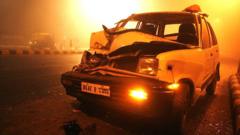India's roads rank among the deadliest in the world, with a life claimed every three minutes. This article delves into the causes, statistics, and potential solutions for improving safety on the country's treacherous roadways.
Tragic Toll: The Alarming Reality of India's Road Safety Crisis

Tragic Toll: The Alarming Reality of India's Road Safety Crisis
A comprehensive look into the road safety issues plaguing India, where over 172,000 lives were lost in 2023 due to traffic accidents.
In 2023, India experienced a staggering surge in road accidents, with over 480,000 incidents leading to the deaths of more than 172,000 individuals. On a daily basis, newspapers report harrowing accounts of tragic crashes involving passenger buses careening off cliffs, intoxicated drivers colliding with pedestrians, and cars smashing into stationary trucks. These alarming statistics reflect a concealed crisis: the harrowing reality that translates into an average of 474 fatalities each day, equating to nearly one death every three minutes.
Although the official annual crash report for 2023 has yet to be published, Road Transport and Highways Minister Nitin Gadkari disclosed these numbers while speaking at a road safety conference in December. Included among the fatalities were 10,000 children, while accidents near educational institutions resulted in another 10,000 deaths. Tragically, 35,000 pedestrians also fell victim to this epidemic, with two-wheeler riders disproportionately affected. Over-speeding emerged as the most significant cause of these accidents. Failure to adhere to basic safety measures proved similarly fatal, with a staggering 54,000 deaths attributed to the non-use of helmets and 16,000 related to a lack of seatbelt use.
Other prevalent issues include overloading, responsible for 12,000 deaths, and incidents involving drivers operating without valid licenses, constituting around 34,000 collisions. Reckless driving behaviors, such as operating vehicles against traffic rules, contribute significantly to the alarming accident rates. Notably, in 2021, 13% of road incidents involved drivers with either learner's permits or no valid licenses. A critical aspect exacerbating this dangerous landscape is the prevalence of outdated vehicles lacking essential safety specifications like seatbelts and airbags.
India's complex road environment further compounds these issues. Streets are shared by an overwhelming variety of users, including motor vehicles such as cars and motorcycles vying for space alongside bicycles, hand-carts, and pedestrians, not to mention hawkers obstructing pathways. Despite the implementation of investment and safety efforts, India's roadways remain entrenched among the most hazardous globally. Experts attribute this multifaceted crisis to a combination of inadequate infrastructure, behavioral patterns, lack of enforcement, and systemic neglect.
The economic burden of road accidents is staggering, amounting to approximately 3% of India's annual GDP. India boasts the world's second-largest road network, spanning 6.6 million kilometers, trailing only the US. National and state highways form about 5% of this total, with diverse routes encompassing expressways and local roads, all of which accommodate an estimated 350 million registered vehicles.
Minister Gadkari asserted at the safety gathering that a lack of respect for legal mandates underpins many of these accidents. He emphasized that, while human behavior remains a contributor, broader issues such as faulty civil engineering, inadequate road design, deficient signage, and markings substantially increase accident susceptibility. Gadkari highlighted significant deficiencies reported since 2019 in national highways and stated that of the 13,795 identified "black spots" prone to accidents, only 5,036 had undergone substantial rectification.
Audits conducted by the Transportation Research and Injury Prevention Centre at IIT Delhi have unveiled severe shortcomings in India's road infrastructure. For instance, crash barriers are meant to prevent vehicles from tumbling but often prove counterproductive due to incorrect installation. Similarly, inadequate median designs can lead to hazardous vehicular rollover scenarios, particularly dangerous on high-speed roads where traffic routinely speeds by residential areas.
The potential for improvement exists but hinges upon proper enforcement of design standards. Current penalties for failing to adhere to safety regulations are minimal, and construction contracts often prioritize kilometrage over compliance. Following an announcement of plans to expand and upgrade 25,000 kilometers of roads from two to four lanes, experts stress that without a corresponding emphasis on safety engineering, such upgrades could exacerbate the crisis.
Kavi Bhalla of the University of Chicago cautions against assumptions that road widening will result in decreased fatalities. He notes that India's road designs frequently replicate Western standards which might not cater to the country's unique traffic conditions. Advocates are promoting a holistic "5Es" strategy—engineering, education, enforcement, and emergency care—to revitalize road safety and reduce accidents.
As road development continues, the unyielding reality remains clear: the construction of infrastructure must not overshadow the paramount need for pedestrian safety. Failing to address these concerns threatens to transform smoother roads and faster vehicles into an increasing death toll on Indian streets.






















